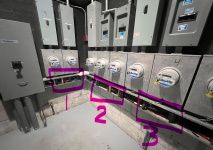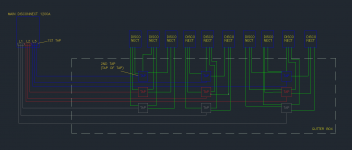VENgineer
Member
- Location
- Miramar Fl
- Occupation
- Electrical Engineer
Good afternoon, I hope you can help me with this situation.
Yesterday, I conducted an inspection in a 2-story commercial building and encountered the following.
Main Disconnect 1200Amps. 4 sets of 350MCM CU are entering. 3 sets of 350MCM CU are exiting (First violation since the ampacity is below the OCPD) as it is still considered a feeder and not a tap conductor.
Then, and even more surprising, each of the conductors goes to a different polaris tap, not as parallel conductors to the same polaris tap. I see this as a clear violation of 240.21, Tap of Tap.
I will make a diagram to help you understand better, and please confirm if I am correct or if I am missing something.

Yesterday, I conducted an inspection in a 2-story commercial building and encountered the following.
Main Disconnect 1200Amps. 4 sets of 350MCM CU are entering. 3 sets of 350MCM CU are exiting (First violation since the ampacity is below the OCPD) as it is still considered a feeder and not a tap conductor.
Then, and even more surprising, each of the conductors goes to a different polaris tap, not as parallel conductors to the same polaris tap. I see this as a clear violation of 240.21, Tap of Tap.
I will make a diagram to help you understand better, and please confirm if I am correct or if I am missing something.





